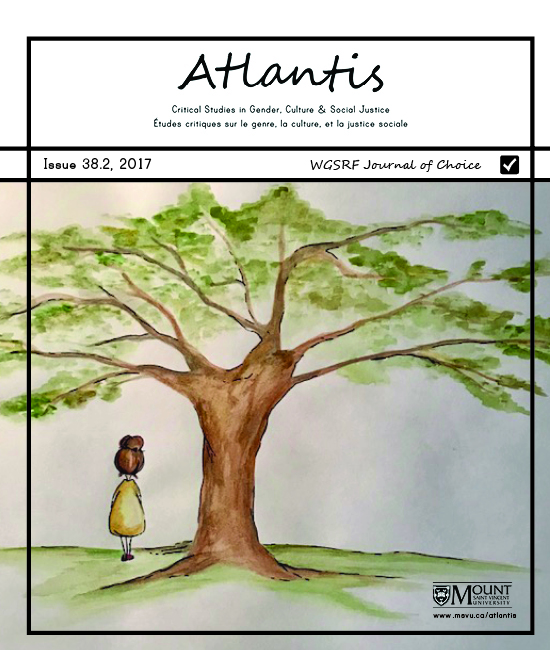Posthumanist Feminism and Interspecies Affect in Nalo Hopkinson’s Midnight Robber
Keywords:
Speculative fiction, posthumanist feminism, cyborgs, affectAbstract
Abstract
This paper examines the posthuman affective communities in Nalo Hopkinson’s dystopia Midnight Robber (2000), from an intersectional approach. It focuses on the interspecies affinity developed between a cyborg Black girl and other posthuman beings in outer space, where subaltern ‘artisans,’ machines, and indigenous communities provide nurturing affects of love and compassion that engender mutual respect and solidarity.
Résumé
Cet article examine les communautés affectives posthumaines dans la dystopie Midnight Robber (2000) de Nalo Hopkinson, selon une approche intersectionnelle. Il met l’accent sur l’affinité interspécifique qui se développe entre une cyborg noire et d’autres êtres posthumains dans l’espace, où des « artisans » subalternes, des machines et des communautés indigènes fournissent des affects enrichissants d’amour et de compassion qui engendrent le respect mutuel et la solidarité.
Metrics
References
Ahmed, Sara. 2000. Strange Encounters: Embodied Queers in Post-Coloniality. London, UK: Routledge.
Atwood, Margaret. 2011. In Other Worlds: SF and the Human Imagination. New York, NY: Nan A. Talese/Doubleday.
Barr, Marleen S., ed. 2008. Afro-Future Females: Black Writers Chart Science Fiction’s Newest New-Wave Trajectory. Columbus, OH: Ohio State University Press.
Boyle, Elizabeth. 2009. “Vanishing Bodies: ‘Race’ and Technology in Nalo Hopkinson’s Midnight Robber.” African Identities 7 (2): 177-191.
Braidotti, Rosi. 1994. Nomadic Subjects. New York, NY: Columbia University Press.
___. 2006. “Posthuman, All Too Human. Towards a New Process Ontology.” Theory Culture Society 23 (7-8): 197-208.
___. 2013. The Posthuman. London, UK: Polity.
Caluya, Gilbert. 2014. “Fragments for a Postcolonial Critique of the Anthropocene. Invasion Biology and Environmental Security.” In Rethinking Invasion Ecologies from the Environmental Humanities, edited by Jody Fwaley and Iain McCalman, 31-44. London, UK: Routledge.
Castells, Manuel. 1996. The Rise of the Network Society. Malden, MA: Blackwell.
___. 2000. “Materials for an Exploratory Theory of the Network Society.” British Journal of Sociology 51 (1): 5–24.
Dillon, Grace L. 2007. “Indigenous Scientific Literacies in Nalo Hopkinson’s Ceremonial Worlds.” Journal of the Fantastic in the Arts 18 (1): 23-41.
___. 2008. “Totemic Human-Animal Relationships in Recent Sf.” Extrapolation 49 (1): 70-96.
Dubey, Madhu. 2008. “Becoming Animal in Black Women’s Science Fiction.” In Afro-Future Females: Black Writers Chart Science Fiction’s Newest New-Wave Trajectory, edited by Marleen S. Barr, 31-51. Columbus, OH: Ohio State University Press.
Enteen, Jilliana. 2007. “‘On the Receiving End of the Colonization’: Nalo Hopkinson’s ’Nansi Web.” Science Fiction Studies 34 (2): 262-282.
Haraway, Donna. 1991a. “Situated Knowledges: The Science Question in Feminism and the Privilege of Partial Perspective.” In Simians, Cyborgs and Women: The Reinvention of Nature, by Donna Haraway, 183-201. New York, NY: Routledge.
____. 1991b. “A Cyborg Manifesto: Science, Technology, and Socialist-Feminism in the Late Twentieth Century.” In Simians, Cyborgs and Women: The Reinvention of Nature, by Donna Haraway, 149-181. New York, NY: Routledge.
_______. 1999. “The Promises of Monsters.” In Cybersexualities: A Reader on Feminist Theory, Cyborgs and Cyberspace, edited by Jenny Wolmark, 314-366. Edinburgh, UK: Edinburgh University Press.
Hardt, Michael, and Antonio Negri. 2004. Multitude: War and Democracy in the Age of Empire. New York, NY: Penguin.
Hayles, N. Katherine. 1999. “The Life Cycle of Cyborgs: Writing the Posthuman.” In Cybersexualities: A Reader on Feminist Theory, Cyborgs and Cyberspace, edited by Jenny Wolmark, 157-173. Edinburgh, UK: Edinburgh University Press.
Hopkinson, Nalo. 2000. Midnight Robber. New York, NY: Warner Books.
___. 2012. “Report from Planet Midnight.” In Report from Planet Midnight Plus…, by Nalo Hopkinson, 27-50. Oakland, CA: PM Press.
Kamboureli, Smaro, and Roy Miki, eds. 2007. Trans.Can.Lit: Resituating the Study of Canadian Literature. Waterloo, ON: Wilfrid Laurier University Press.
Knepper, Wendy. 2013. “Cross-Dressing and the Caribbean Imaginary in Nalo Hopkinson’s Midnight Robber.” In The Cross-Dressed Caribbean: Writing, Politics, Sexualities, edited by Maria Cristina Fumagalli, Bénédicte Ledent, and Roberto del Valle Alcalá, 140-156. Charlottesville, VA: University of Virginia Press.
Langer, Jessica. 2011. Postcolonialism and Science Fiction. Houndmills, UK: Palgrave Macmillan.
Mbembe, Achille. 2003. “Necropolitics.” Public Culture 15 (1): 11-40.
Nelson, Alondra. 2002a. “Introduction: Future Texts.” Afrofuturism. Social Text 71: 1-15.
___. 2002b. “Making the Impossible Possible. An Interview with Nalo Hopkinson.” Afrofuturism. Social Text 71: 97-113.
Pordzik, Ralph. 2001. The Quest for Postcolonial Utopia: A Comparative Introduction to the Utopian Novel in the New Literatures in English. New York, NY: Peter Lang.
Rutledge, Gregory E. 2001. “Futurist Fiction and Fantasy: The ‘Racial’ Establishment.” Callaloo 24 (1): 236-252.
Sandoval, Chela. 1999. “New Sciences: Cyborg Feminism and the Methodology of the Oppressed.” In Cybersexualities: A Reader on Feminist Theory, Cyborgs and Cyberspace, edited by Jenny Wolmark, 247-263. Edinburgh, UK: Edinburgh University Press.
Thaler, Ingrid. 2010. Black Atlantic Speculative Fictions: Octavia E. Butler, Jewelle Gomez, and Nalo Hopkinson. New York, NY: Routledge.
Thomsen, Mads Rosendahl. 2013. The New Human in Literature: Posthuman Visions of Changes in Body, Mind and Society after 1900. London, UK: Bloomsbury.
Wolfe, Cary. 2010. What is Posthumanism? Minneapolis, MN: University of Minnesota Press.
Downloads
Published
Issue
Section
License
Authors who publish with this journal agree to the following terms:
1. Authors retain copyright and grant the journal right of first publication, with the work simultaneously licensed under a Creative Commons Attribution 4.0 International License that allows others to share the work with an acknowledgement of the work's authorship and initial publication in this journal.
2. Authors are aware that articles published in Atlantis are indexed and made available through various scholarly and professional search tools, including but not limited to Erudit.
3. Authors are able to enter into separate, additional contractual arrangements for the non-exclusive distribution of the journal's published version of the work (e.g., post it to an institutional repository or publish it in a book), with an acknowledgement of its initial publication in this journal.
4. Authors are permitted and encouraged to preprint their work, that is, post their work online (e.g., in institutional repositories or on their website) prior to and during the submission process. This can lead to productive exchanges, as well as earlier and greater citation of published work. Read more on preprints here.






